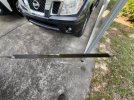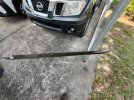Oil level
- Thread starter Palmheel
- Start date
I noticed an overfilled oil level when picking up my new '23 forester..every time I take it to the dealer for an oil change, the service tech overfills...seems to be fairly common complaint here so I wonder if it's done intentionally..some older models had a history of excessive oil use...
The oil dipstick was showing about half inch over the full mark, so being old school and concern of overfilled I drained to the full mark (cold). This is the amount drained, it doesn’t look like much, so maybe it wouldn’t have damage seals etc., is approximately 300 cc.
Attachments
I know your question concerned "overfill" and I cannot add anything to the conversation on newer Subaru's but in general, oil quantities and reading dipsticks in many modern vehicles seem to leave much confusion among those who change their own oil (and even among the "pro's" it seems.) I think the synthetic oils don't really want to cling to the dipstick anyway; so by the time you get the stick outta many engines and up to your eyes all traces of the higher levels it might have just reached are gone. Add to that knurling or crosshatching that might help retain the oil in the area of the stick we're most interested in is often not present. I have a 2016 Honda CRV that has the most befuddling dipstick. When I change the oil, despite the Owner's Manual prescribing 4.6 qts with filter change, it often takes closer to 5 qts. I think the mfg's guilty of contributing to these situations could do a better job without it costing them too much profit.
- Joined
- Jul 31, 2023
- Messages
- 454
- Reaction score
- 100
This is not true. "Synthetic" oil is just oil with the same size particles.....not magic. It also get just as dirty as regular dino oil. Crosshatching is likely used for an easier visual, not for "holding" oil. Nearly all of my vehicles have just had two small holes in the center of the dipstick or two small cutouts on the edge. Flashlights can help. So can laying it on a paper towel and seeing where the oil gets on the towel.I think the synthetic oils don't really want to cling to the dipstick anyway;
Another likely culprit to oil levels changing is that oil filters for the same vehicle hold wildly different amounts based on filter manufacturer and p/n.
Most folks focus on oil level perfection too much. Close enough is close enough. Nearly nowhere that they check it is perfectly level. Their tires aren't perfectly worn or inflated. Fuel load changes how the car site. It just isn't as precise as people think...
Completely experience all that. Combo of synth oil and dipstick structure makes harder to read than the old days. A bit easier if oil is dirty. I often have to dip 3 or 4 times.I know your question concerned "overfill" and I cannot add anything to the conversation on newer Subaru's but in general, oil quantities and reading dipsticks in many modern vehicles seem to leave much confusion among those who change their own oil (and even among the "pro's" it seems.) I think the synthetic oils don't really want to cling to the dipstick anyway; so by the time you get the stick outta many engines and up to your eyes all traces of the higher levels it might have just reached are gone. Add to that knurling or crosshatching that might help retain the oil in the area of the stick we're most interested in is often not present. I have a 2016 Honda CRV that has the most befuddling dipstick. When I change the oil, despite the Owner's Manual prescribing 4.6 qts with filter change, it often takes closer to 5 qts. I think the mfg's guilty of contributing to these situations could do a better job without it costing them too much profit.
- Joined
- Jun 25, 2024
- Messages
- 361
- Reaction score
- 103
What the world needs is a better dipstick or perhaps something easier to read altogether.
Ask a Question
Want to reply to this thread or ask your own question?
You'll need to choose a username for the site, which only take a couple of moments. After that, you can post your question and our members will help you out.
Similar Threads
Forum statistics
Latest Threads
-
Wrong battery put in crosstreck
- Started by Ren_chapman
-
Question for New Impreza owners
- Started by Wesnah73
-
The car's bluetooth switch will not stay on
- Started by bbob
-
Chirping Sound On Cold Start And Initial Acceleration 2016 Forester
- Started by Kenrose
-
Fluid puddle about under rear of cargo area on ground
- Started by biglakebubba
-
Hitch on new purchase
- Started by semag93
-
Rusted brake line
- Started by twj815
-
2015 Subaru Impreza 1.6 Front ABS problems
- Started by James87
-
Subaru maps
- Started by HIGHTIDE
-
What parts fit a 1998 impreza?
- Started by mxttixs




